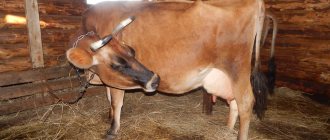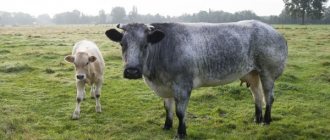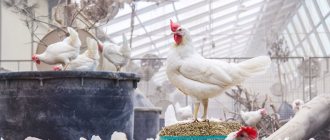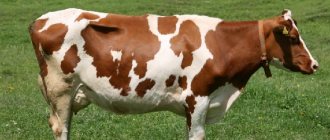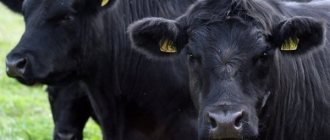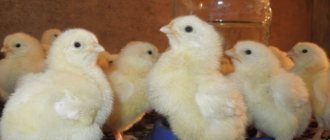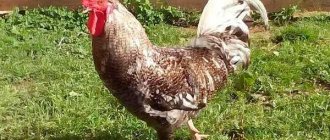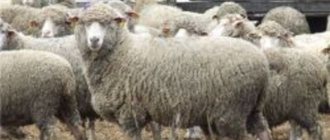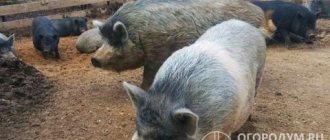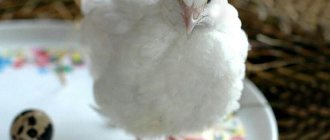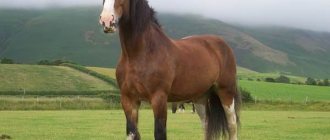The Montbeliarde breed of cows is considered an elite species. It has been bred in France since the 18th century. Centuries of special selection have produced excellent results. In 1889, the Paris World Exhibition highly appreciated the uniqueness of the breed. Breeders were able to develop cows with exceptional milk and meat qualities, which are still valued all over the world.
Milk yield characteristics
The fat content of the milk of Montbeliarde heifers is 4%, the protein content in it is 3.45%.
A Montbeliarde cow produces up to 8,000 kg of milk per year. A cow produces a large volume of product in one milk. Lactation lasts 305 days. Milk yield indicators are stable and may change slightly with changes in diet. The fat content of milk always remains constant. The Montbéliarde heifer produces milk that has excellent taste. It is used for the industrial production of elite varieties of cheese, cottage cheese, and yogurt. The dairy product from Montbeliarde cattle is in great demand due to its excellent taste and nutritional value.
Origin story
Purposeful selection of the animal began in the 18th century in Switzerland and France. Local cattle breeders have set themselves the goal of developing a new breed, characterized by endurance, unpretentiousness and increased productivity.
To do this, breeders crossed Swiss outbred cows with Alzan, Pied and Charolais breeds. Breeding work lasted for a century, after which in 1889 at the World Exhibition (France) the official recognition of Montbéliardes took place.
Did you know? The breed has the most elegant appearance among its relatives, which is why Montbéliardes annually become participants in hundreds of advertising videos about milk.
Today these cows are considered one of the most advanced in the world. The predominant number of individuals is concentrated in the homeland of the artiodactyl, in France. In addition, the high productivity of this cow contributed to its spread throughout the planet, so herds of Montbéliardes can be found en masse in America, Africa and Europe.
Differences in the Swiss breed by area
All areas where this species has spread differ in natural and economic conditions. German and Austrian Swiss bulls and heifers have shorter legs and smaller bodies. In France and Italy they are larger, have good health and high milk yield.
The productivity of the Swiss brown cow, which lives in Switzerland and France, is approximately 6 to 6.8 thousand kg of milk per year. Its fat content is 4%, and the amount of protein is more than 3%. In the climatic conditions of Austria, heifers of this species are less productive: their milk yield averages 5 thousand kg of milk per year.
Milk has a high fat content (4.1%), which is why cheese, chocolate and other dairy products are made from it
In many ways, the productivity (milk yield) of heifers depends on the area where they graze. However, the chemical composition and biological properties of milk do not change depending on the type of pasture.
Schwyz breed in Russia
The breeding of the Swiss brown breed in Russia began at the beginning of the 20th century.
Adults were imported, but heifers were especially prized.
After the appearance of the new species, active purebred breeding began. In addition, bulls were also used to improve the characteristics of local species. In the 20s of the last century, individuals with the best performance were bred at the Moscow Academy of Agriculture. After that they spread throughout the country. Their main purpose was to produce milk, but on some farms they were also raised for meat.
Meat quality
The results of fattening Montbéliarde calves are more than satisfactory: due to their high growth rate, they achieve greater carcass weight. Slaughter occurs earlier because the fattening period is shorter.
An undoubted advantage of Montbéliarde is also the best body structure of the animals, which directly affects the classification of the carcass (75% of calves receive the R classification in the EUROPA quotation system).
And one more advantage: the feed consumption ratio of Montbeliarde is lower than that of Prim'Holstein, which is evidence of more efficient use of feed.
In Poland, an increasing number of Polish livestock enterprises, attracted by such properties of the breed as excellent milk composition, unpretentiousness, and versatility, are choosing purebred breeding of Montbéliarde. For example, the organization MONTAGRO has been working with this breed for more than 5 years. The goal of the investors was to acquire a “problem-free” and at the same time highly productive breed of cattle.
Already in the first lactation, Montbeliarde cows confirmed investors in the correctness of their choice, showing an average productivity of 9652 kg of milk with a protein content of 36.0 ‰ and fat 42.0 ‰. The average for the twenty best lactations in 2010 was 12,798 kg with a protein content of 34.6‰ and fat content of 45.2‰.
In the UK, the Briton James Hodge, since 2004, has been conducting the largest informal research on crossbreeding cattle with the Montbéliarde breed in the United Kingdom (Lancashire). The goal of the study was to increase productivity due to the heterosis effect.
Background A herd of 350 Holstein dairy cows, the result of 30 years of breeding work, milking 3 times a day, average productivity 9500 l/cow. Since 2004, insemination has been carried out only with semen from Montbéliarde bulls.
Results Reproductive function: Pregnancy after the 2nd attempt at AI occurred in Montbeliarde hybrids - in 71% of cases, in purebred Holsteins - in 53% of cases Productive longevity: 86% of Montbeliarde hybrids calving in 2007 began their 4th lactation in 2010 .
The carcass value of cull Montbéliarde cows is approximately €180 higher than that of Holstein cows. There are no cases of displacement of the abomasum. For the first time in 20 years, the veterinary isolation ward is almost always empty.
Health indicators in hybrid animals: significant reduction in the incidence of problems associated with mastitis and metritis.
Milk productivity: the average milk sold reaches 8950 L per cow (data for the period 2009-2010), with a protein content of 33.5 ‰ and fat 41.5 ‰. Somatic cells: 150,000 + 6% or more than purebred Holsteins 3rd breed 8 MONTBELIARD
Description and distinctive features of the breed
Like any other species, Montbeliards have characteristic features and a recognizable appearance. As a result, even an untrained livestock breeder can easily identify this animal among thousands of others. In addition to excellent production indicators, this cow has quite impressive size, as well as a characteristic appearance.
Did you know? Over the past few decades, Montbéliarde bulls have been actively used for crossing with outbred individuals: this helps to increase the productivity of the future herd at minimal cost.
Appearance and physique
Montbeliards are distinguished by the following external features:
- the head is large, with a slight expansion in the eye sockets;
- the muzzle is large, but symmetrical, has the typical outlines of the European line of cows;
sides - deep;
neck - powerful, medium length;
the chest is deep, bulls are characterized by a powerful, wide and well-developed dewlap;
chest depth - 70–78 cm;
the outline of the body is smooth and graceful, which creates a good-natured and calm appearance for the animal (straight back, tightly fitting shoulder blades, dense and massive legs);
croup - located at a slight slope, the spine does not protrude;
height at withers - within 140–150 cm, males are always slightly larger than females;
body length - 160–165 cm;
body weight - for bulls 800–1200 kg, for cows on average about 600–800 kg;
the udder is cup-shaped, the base of the udder is horizontal, in the middle of each quarter there are nipples directed inward. Numerous veins are present on the udder;
the location of the udder is higher than the ham, in the back side the udder is located higher than in the front;
tail - medium length;
the coat is short, soft, but dense;
color is red-motley, the cow can be distinguished by the white coloring of the lower part of the body, as well as bright purple spots on the back. The head is white, with characteristic purple spots on the cheeks.
Important! A distinctive feature of Montbéliardes are light mucous membranes of pink or cream tones, as well as a white tail with a fluffy white tassel. . Meat and dairy indicators
Meat and dairy indicators
Montbeliards are distinguished by high-quality livestock products, regardless of the conditions of detention and the period of the year.
The main value of an animal is excellent milk. It is suitable for any purpose and culinary needs, which makes it possible to create high-quality lactic acid products from it, as well as use it for preparing other dishes (milkshakes, condensed milk, etc.). Also, milk’s high protein content and low fat content make it the best raw material for the industrial production of milk powder.
The main production indicators of a cow during dairy rearing:
- productivity - high;
- lactation period - 300–305 days a year;
- average annual milk yield - 7800–8500 liters;
- milk fat content - 3.5–4%;
- amount of protein - about 3.5%;
- the taste of milk is delicate and pleasant;
- The color of the milk is white, but sometimes a light creamy tint can be observed.
Find out more about cow's milk: density, fat content, composition, benefits and harms.
The Montbeliarde cow also competes well in the meat market: its meat is distinguished by its tenderness and unique taste. That is why such meat is often served as the main decoration of the table in many gourmet restaurants.
The main production indicators of a cow during meat rearing:
- rate of weight gain - high;
- increase in live body weight per day - 1.2–1.4 kg (depending on nutrition);
- slaughter yield of carcass - about 54% for cows, about 58% for bulls;
- grade of meat - highest;
- the color of the meat is uniform, rich, often pink-red in young individuals, red-scarlet in mature ones;
- the smell of fresh meat is rich, meaty, with a slight aroma of milk;
- fatty layers in meat are few, practically absent.
Advantages and disadvantages
The main advantages of the breed:
- fairly high productivity;
- low percentage of fat in products;
- high quality meat and milk;
- unpretentiousness.
The main disadvantages of the breed:
- low yield of meat products;
- need for high quality feed;
- low resistance to seasonal diseases and infectious lesions;
- increased demands on living conditions (than in outbred cows).
Did you know? Montbéliarde is one of the few breeds whose milk is used to make gourmet cheeses, named after the place where it was made. The most popular of them is Emmental cheese, made in the Emme River Valley (Switzerland).
What features of the Kalmyk cattle breed should every livestock breeder know about?
The Kalmyk breed of cows tends to accumulate reserve nutrients in the body, especially fats. This feature begins to clearly manifest itself in late autumn, before the onset of winter, and this property is not lost even when pastures are scarce and the cattle were kept only on dry pasture.
Fat deposits initially begin to form as watering under the skin, then on the internal organs, inside the muscles and between them.
If there is a shortage of feed in winter, the stored fats begin to be used in the reverse order. Based on this, seasonal dynamics of live weight and fatness are observed in Kalmyk breed cattle.
A cow can lose from 30 to 70 kilograms of live weight over the winter. At the same time, before going out to pasture, she will look averagely well-fed. If the pasture was good before winter, the cow will have the highest body condition.
The digestive tract of these animals is very well developed and this allows them to eat a large amount of pasture grasses and bulky, roughage feed. All received nutrients are absorbed by the body as much as possible.
What helps Kalmyk cows tolerate contrasting temperature conditions?
We have repeatedly emphasized the extraordinary endurance of the breed. It is also worth talking in more detail about the uniqueness of the skin of Kalmyk cows, which is the basis of this feature.
In addition to the fact that their woolen hair is very long and has protective properties, it is also diluted with warming fluff.
During warm periods of the year, after molting has ended, the body becomes covered with smooth, shiny fur that reflects the sun's rays. Which in the future, with the beginning of warm days, allows animals to spend maximum time in the steppe and on mountain slopes. No other breed of cattle can boast of this feature.
Stable body temperature - this unusual and at the same time valuable ability of the body has always aroused increased interest among experienced cattle breeders.
The essence is the ability to maintain a stable body temperature both under the sultry sun, and under the blowing of freezing winds, and in harsh wintering conditions. Scientists noted only minor fluctuations of a few degrees.
This stability continues throughout the year. In these animals, with the onset of cold weather, the dermis thickens. It is worth noting the huge number of sebaceous and sweat glands on the skin.
Features of breeding Kalmyk cows today
Recently, the Kalmyk breed has increasingly begun to be used to improve the meat qualities of certain dairy and meat breeds of cattle and for industrial crossbreeding.
This breed is an excellent source of genetic material. Experiments have shown good results in obtaining high-quality cattle for fattening from Kalmyk queens.
Currently, about 90% of the Kalmyk breed of cattle lives in the arid steppes and semi-desert zones of Russia. In such current conditions, there is no other breed of cows for meat production that could compete with Kalmyk animals.
The breed is also becoming especially popular for home keeping, since it is suitable for extensive cultivation. The only thing stopping many cattle breeders is that raising Kalmyk cows requires large pastures.
Previously, oxen of this breed of cattle were often used as labor, which is also still practiced in the northern regions of Russia. Today, oxen are of great value due to the high taste of their meat.
Use of semen from Montbéliarde bulls.
The semen of Montbéliarde bulls is used not only for insemination of the Montbéliarde breed, but it improves the low-producing breed, creating new highly efficient types of cattle. Sperm from bulls of this type is used in a variety of crossing methods:
- Absorption crossbreeding: two types of cattle are mated when an improved type of cow is absorbed by the Montbeliarde breed;
- Crossbreeding is variable, in order to obtain highly productive individuals: the result of a mixture from the copulation of two or three types of livestock and in the gradual crossing of crossbred queens in several generations with bulls of the original species. This type of crossing makes it possible to introduce the phenomenon of heterosis in crossbred cattle not only in the first generation, but also in subsequent ones.
Therefore, the method of improving livestock with sperm from Montbeliarde bulls is a highly effective method.
Montbéliarde genes can improve herd performance
Advantages and disadvantages
Among the advantages of the Montbeliarde breed are high-quality tasty meat and milk, endurance, and unpretentiousness. Cows have a low percentage of somatic cells - this significantly reduces the risk of developing mastitis. Individuals are distinguished by easy calving and a high percentage of fertilization.
Expert opinion
Zarechny Maxim Valerievich
Agronomist with 12 years of experience. Our best country expert.
Ask a Question
Among the disadvantages is the complex nature of Montbeliards. From time to time this creates difficulties in breeding and milking
.
History and popularity of Montbéliarde cows
This type of cow was bred in France. But the roots go back to Switzerland, because in the 18th century the ancestors of Montbeliarde cattle were brought to French territory from Switzerland. For more than a century, breeders have worked to develop a type of cow whose milk would be suitable for the production of local cheeses. In the French region of Franche-Comté (the birthplace of the Montbéliardes), milk from this breed was selected to supply factories producing cheese. In 1889, at the World Exhibition in Paris, the Montbéliarde cow was officially recognized. At the same time, a studbook of Montbeliarde cattle was published. This species was bred by crossing the French Alzan with the Swiss Simmental, using a special diet. The French breed this breed in mountainous areas. For example, in Franche-Comté, Montbéliardes make up 95% of the dairy cattle. It is this milk that is necessarily included in the cheeses of this region. At the same time, meat is also valued. The cow grows quickly, has a good physique, and as a result, crossing it with a Charolais bull produces calves that are valued for their meat quality. Montbéliardes are quite popular in Central Europe, North Africa, Australia, etc. This type of livestock is represented in more than fifty countries of the world and in all climatic sectors. They are bred to breed a pure, highly efficient Montbéliarde breed and to improve the local stock.
Montbéliarde cows thrive in all climate zones
Habitats
The name of the breed comes from the French county of Montbéliard. Cow's milk is used to prepare a special type of cheese, which has excellent taste. In France, the Montbéliarde breed loves to graze in the mountains, in the foothills.
Animals are exported to farms around the world. They take root well in Australia, Tunisia, Morocco, England, and the countries of the Middle East. They are bought to improve the quality characteristics of their own livestock and breed pure breeds. The cost of one adult individual is approximately 100,000 rubles.
Feeding cows
Proper feeding of Montbeliarde cattle, like all breeds, includes a diet that saturates the individual’s body with the necessary vitamins, minerals and trace elements in the right combination, and in an assimilable form. Adequate nutrition should provide the cow with high productivity, maintaining her physical and physiological condition.
Young cows with one or two calvings that are still growing and exhausted cattle should increase their feeding ration. The nutritional gain is calculated depending on the daily weight gain. For 1 kg. for weight gain, five feed units, 500 grams of digestible protein, 40 grams of calcium, 30 grams of phosphorus are added.
Montbéliarde cows need a large amount of succulent feed
A cow with high productivity requires an increase in the amount of milking, therefore, it is necessary to increase the feeding times. Typically, two or three meals a day are used, at equal time intervals.
On days 4-7, give boiled water, cooled (+15-20 degrees). At three weeks of age, you can already give water in a raw, but pure form. At six months of age, the nutrition of calves is similar to that of adults. Basic nutrition for calves includes:
- succulent feed;
- corn silage;
- roots;
- hay;
- concentrated feed.
How does the breeding process work?
Animals of this amazing breed can be kept without a leash or in separate compartments. Depending on the planned livestock, premises are selected. It must have certain parameters. Cows are responsive to care. Because of the cold, drafts and dampness, they begin to have problems with weight gain, milk production, and may develop mastitis.
The barn should be located a short distance from water sources and residential buildings. There are sanitary standards according to which the distance to a working well or borehole must be at least 20 meters. This will ensure the purity of drinking water. The rules provide for a minimum distance of 15 meters to a residential building. To quickly sell manure, it is recommended to build a barn next to the garden or vegetable garden.
Particularity of Montbéliardes
Creatures deserve great size and proportional stature. Tulub with a long length of 1.62 m to 1.65 m. The head is large, the chest is deep. The hips swell with the expansion of the chest. Wide back, tight knuckle, great size.
The weight of the bik is 900-1200 kg, the cow gains 600-700 kilograms. New thinness at the waist gives a height of 135 cm to 140 cm
The breeding of the creature is similar to that of a similar red-and-spotted breed. The Montbéliarde breed is characterized by:
High milk productivity. The value of a dairy product that consists of a certain percentage of fat and protein. Even more valuable meat authorities. Energy of development and growth. Shvidki ripened. You are as great as a cup. Stay tuned until you reach the end of the unpleasant weather. Good health and long life.
The milk of Montbéliardes has an excellent combination of milk fat and protein, and individuals undergo triple lactation. Their meat, among the world's fakhivtsi partnership, is recognized as being of high quality.
Give Montbeliarde cows fatter and tastier milk
Feeding
Animals are unpretentious in food and digest roughage, but for rapid development and good milk yield, it is better to make the diet rich and contain all the necessary microelements. Like any livestock, they need minerals and trace elements; poor nutrition will have a detrimental effect on the quality of milk and can lead to cattle disease. Young, growing or malnourished cattle require increased rations containing higher levels of protein, calcium and phosphorus. Dairy cows need to be milked more often and, accordingly, increase the number of feedings to 3 times a day at regular intervals.
Newborn calves can be given boiled water after a week, and in the third week of life they can switch to raw, clean water. By 6 months, calves are already eating the same as their adult relatives. The calf's diet should contain:
- fresh succulent food;
- various root vegetables;
- hay;
- silage;
- concentrated feed.
Good feeding of calves can affect their future growth and health; young animals, like children, require special attention to the quality of feed and the quantity of feedings.
What to feed
Cows of the Kazakh white-headed breed are also unpretentious in food, however, only a balanced diet allows for maximum weight gain.
The diet of these animals can be divided into 2 periods:
- summer, when animals receive maximum nutrients from the pasture;
- winter, when the animal needs a large amount of nutrients.
Summer grazing on a pasture
During this period of the year, feeding cows is not difficult. They require free walking in the pasture, where they themselves will find everything they need for food. However, the pasture needs to be changed regularly, for example once a month. At the same time, you need to choose a productive one so that there is at least 8 centners of greenery on one hectare.
Did you know? Cows of the Kazakh white-headed breed are considered one of the hardiest, as they can cover up to 30 km in a day under the merciless scorching sun.
If free walking of livestock on the pasture is not possible, then a feeder with hay is installed in the pen. Grains, beets and silage are given as additional feeding. Animals also need to be given additional vitamin supplements and bone meal. The diet of breeding bulls mostly contains grains and legumes.
Feeding diet in winter
In winter, cattle need an additional source of nutrients. The winter diet of the Kazakh Whitehead consists of 60% roughage (straw) and 40% concentrated feed.
The animals are given compound feed, hay, and silage. Cereals, root vegetables and legumes are also included in the diet. Don’t forget about vitamins and other nutritional elements; additional supplements made from bone meal, phosphates, chalk and calcium are added to the diet.
Water and table salt
A cow, like any other animal, needs water. Since cows are quite large animals, they therefore require a large amount of fluid. The animal drinks 10 times a day, and at one time they are able to drink up to 15 liters of water. Accordingly, on average, one animal needs about 150 liters. Of these, only 30–35 liters are needed to maintain vital processes in the body.
Another integral component in the diet of cows is table salt. An animal cannot obtain this element from plant foods, so it is given as additional food. Salt is involved in the synthesis of hydrochloric acid, which is formed in the stomach.
Sodium is involved in the functioning of nerve endings and also maintains the health of muscle and bone tissue. In addition, sodium affects the percentage of fat in milk. Sodium chloride helps maintain salt balance in the body. It participates in the metabolic process and has antibacterial properties.
However, table salt also has its disadvantages. For example, its excess causes dysfunction of the genital organs, the formation of cysts, and a decrease in the amount of milk
That is why it is very important to monitor the daily allowance that is given to cows
The daily intake of table salt can vary depending on the weight of the animal, the amount of milk the animal produces, and the time of year. For normal functioning of the cow’s body, she is given NaCl at the rate of 5 g for every 100 kg of live weight and 4 g for each liter of milk.
Salt can be given in bulk, but in this case there is a high probability of overdose. However, the use of salt slimes allows you to provide the necessary amount of NaCl. They can be hung near the feeder, where the animal cannot trample the licks.
How to care for the breed
Montbeliards are unpretentious to the conditions of their detention. The main rule is a warm room in winter, daily walks in the warm season and a balanced diet. It is necessary to walk individuals daily, weather permitting. Release animals into pastures or meadows. During the winter season, cows and bulls are kept in warm rooms.
The health of future offspring will depend on how properly you care for your animals. Carry out regular cleaning of the premises where cows are kept and clean the stalls. Feeders and drinkers should also be washed periodically using special products. The Montbéliarde breed should be kept in a spacious room so that each individual has enough space. After calving, cows and their offspring need to be given a spacious stall to accommodate the calves and their mothers.
Cleaning mode in the barn
They clean the barn twice a day in the morning and evening hours. If animals are kept without a leash, then the premises must be cleaned 3 times. With the deep litter technique, there is less to clean up.
Important! Manure is cleaned into special channels through which it is discharged outside. If such channels are not equipped during construction, then feces are transported on carts.
New flooring is made after each cleaning; hay can be added during the day as needed. Feeders and drinkers are cleaned before each filling. All food remains must be removed and rinsed well with drinking water using special brushes or other means for animals.
Every month it is necessary to do a general cleaning in the barn. All drinking bowls and feeders are cleaned with soapy water. Extraordinary disinfection is carried out in the following cases:
- when transferring young calves to the barn;
- at the beginning of winter;
- a few days before calving;
- Once every 10 days.
Disinfection is done after general cleaning of the entire animal premises. The solution is used to treat all items in the room. For disinfection, you can use an aqueous solution of formaldehyde (2%) and other liquids.
To obtain a positive result, the solution consumption must be at least 50 ml per square meter. m. After such disinfection, you must wait 3 hours, then rinse all treated items with clean water.
Content Features
Such cattle can be kept either in individual compartments or loose.
The height of the livestock room must be at least 2.5 meters
It is important to clearly divide the space: feeder, stall and place for excrement. For animals of this species, sufficient lighting is important, so windows should occupy at least 10% of the total floor area
The floor must be level. To simplify the process of cleaning the barn, it is preferable to make it from reinforced concrete materials.
Montbeliarde animals require a special microclimate. She needs warm, well-lit and ventilated rooms. Animals do not tolerate frost well. In winter, the room temperature should not fall below 10 °C. The barn should be insulated. In summer, animals feel comfortable at a temperature of 20-25 °C. Drafts are dangerous for them. A sharp drop in temperature can cause long-term colds.
Profitability
At the Dutch Dairy Research Center, work was carried out to compare the Montbéliarde and Holstein breeds in terms of their functional characteristics. After a decrease in income was noted in Dutch livestock farms despite increasing milk quotas, it was decided to conduct an experiment, the goal of which was to produce 460,000 kg of milk from a herd of 70 dairy cows. To achieve this result, two technical and economic objectives were set: reducing production costs and reducing working hours to 50 hours per week.
The Holsteins suffered greatly!
Between 1998 and 2002, the Holsteins were faced with such a system of “low-cost” housing conditions. According to Michael de Haan, who was responsible for conducting the experiment described, “the result is negative, Holsteins did not tolerate the innovation well. The animals began to have health and reproductive problems. We were forced to distribute more feed than the minimum amount specified in the recommended rations.”
The leaders of the experiment decide to compare two breeds within the same herd. 30 Holstein cows were selected, the selection was made according to the criteria of productive longevity, fertility and the number of somatic cells. On the other hand, 30 cows of the Montbéliarde breed were selected; the selection criteria for these animals were reduced only to indicators of productivity and udder morphology.
The Montbeliard breed won an undisputed victory in this competition!
Here are the comparative results of the experiment:
30 Montbéliarde cows passed the test with honor in this experiment, with extremely “simplified” maintenance, where costs were reduced to a minimum. The difference in results is visible mainly in indicators of reproductive function, as well as in indicators of milk composition. In general, Montbéliarde animals showed an economic benefit of 100 euros more than Holsteins, based on 1 head per year.
Research Center WAIBOERHOEVE, Lelystad, The Netherlands Comparative data on purebred animals Montbéliarde/Holstein (2003-2007) (Michael DE GAAN, University of Wageningen, 2007)
Frequent illnesses
Montbeliarde cows have good immunity. But with improper maintenance and lack of basic conditions, there is a risk of infection with infectious pathologies, including:
- Necrobacteriosis or hoof disease is purulent-necrotic processes on the skin, mucous membranes and internal organs of the cow.
- Leptospirosis - pathogens affect internal organs and the central nervous system, the process is accompanied by severe intoxication.
- Actinomycosis is a fungal infection of tissues and organs with the formation of characteristic lesions on the body of a cow.
- Brucellosis is a disorder of the functioning of the reproductive, nervous, skeletal and cardiovascular systems of the cow.
If you notice the first alarming symptoms, you should immediately seek veterinary help. The farmer should be alert to a decrease in milk volume, apathy, partial or complete refusal of food, and an increase in the cow’s general body temperature. Detection of the disease at an early stage is a guarantee of successful and rapid therapy. In most cases, the animal can be completely cured.
The Montbeliarde breed of cows belongs to the “elite” category. Individuals are distinguished by their meat and dairy versatility, which is suitable for both small farms and entire factories. The breed is widespread on all world continents. Features and advantages of Montbeliards - unpretentiousness, endurance, immunity. But suitable housing conditions and good care are a guarantee of high milk yield and tasty meat at the end.
Characteristic
The Montbeliarde cow breed was bred in France and enjoys well-deserved popularity due to its versatility. These horned animals are famous for their solid meat production and high fat content of milk of excellent quality, excellent for cheese production.
Origin
Montbéliardes come from one of the oldest species, widespread in Europe since the Jurassic period. They are distant relatives of the variety of steppe red-motley cows, popular in our latitudes due to their high milk yields and unpretentiousness in feed and weather conditions.
Breeders sought to create a hardy and unpretentious breed with good productivity. As a result of crossing species from all over the Old World, the Montbéliarde breed appeared, which has all the necessary qualities. In the second half of the 19th century, they gained recognition and were included in the stud book at the World Agricultural Exhibition.
Currently, this species is distributed mainly in France among cheese makers, mainly due to the high fat content of milk, but rapid growth rates are also taken into account when choosing. Today, this breed has found its popularity all over the world: in Europe, America, the East and even on the African continent.
Appearance
Montbéliarde cows are distinguished by their original coloring and proportional size, which made them the stars of commercials. The legs and lower part of the body are milky white, while the upper part is colored a bright red-brown. The height of an adult at the withers ranges from 140 to 152 cm.
Montbéliarde cows
A large white head, slightly widened at the eye sockets and spots on the cheeks, a large symmetrical muzzle - the face of European dairy products. It has a fairly powerful neck, which goes into a deep chest; bulls have a developed wide dewlap. Tight shoulder blades, straight back and massive legs. All the outlines are very smooth, in combination with light mucous membranes they create a good-natured appearance, so beloved by children and marketers. In this case, bulls reach a weight of up to 1200 kg, while the weight of a mature cow ranges from 600 to 800 kg.
Milk productivity
The animal is distinguished by high milk productivity; on average, one cow is capable of producing 7700-8500 liters of milk annually. It is distinguished by stable composition indicators, a high milk protein content of 3.45% and a fat content of 3.9-4%. This stability makes the milk drink a favorite raw material for cheesemakers, whose demands are the highest among all dairy industries.
Meat characteristics
Montbeliards rarely get sick and are able to digest even roughage, this has a positive effect on the quality of meat. Such calves have the following meat characteristics:
- net meat yield reaches 68% of the weight of the live carcass;
- low fat content in meat, high animal protein content;
- pleasant, regular coloring of the meat, with a minimal amount of stringy veins;
- fleshy rear part of the carcass (premium meat).
Reference. This breed gains weight very quickly; depending on nutrition, weight gain can be up to 45 kg monthly.
Popular species in Russia and their characteristics
Some of the cattle mentioned above are largely distributed on the territory of the Russian Federation. Below is a list of the main breeds of this type.
Black and white
This breed of cows appeared as a result of crossing Dutch cows with local animals. Thanks to selection, several separate varieties of the black-and-white breed have been developed, adapted to different environmental conditions.
The black-and-white variety can be recognized by the following characteristics:
- dense, proportional build, wide rear;
- thin and fairly long legs;
- thin and elastic skin;
- relatively small head with short horns, flexible long neck;
- black and white color or black color with white spots;
- The udder is medium in size, depending on the region, it can be cup-shaped or round in shape.
It is bred to a greater extent for the production of milk with an average fat content of up to 3.5-4% and a protein content of up to 3.2%. In a year, an individual can produce more than 5 tons of milk. The average weight of a heifer is 500 kg, a male is 750-800. Average slaughter yield ~ 60%.
Holstein
In appearance, Holstein cows can easily be confused with the black and white breed; both have a characteristic black and white color and a fairly dense build. In rare cases, Holstein cows may have a red-brown color.
Holsteins are known as a breed that gains weight well; the specific weight of one cow can in rare cases reach 1 ton, while the weight of a bull is 1200 kg. Calves at birth weigh from 35 to 50 kg, but in a year they can gain up to 800 kg.
Externally, Holstein cows have a short stature (up to 135-140 cm, bulls up to 160 cm), a moderately large build, a wide chest and a developed cup-shaped udder. The head is small, the muzzle is slightly elongated.
Holsteins are known as record holders for milk production in Russia. There are cases when one cow could produce up to 20 tons of milk in a year. The result, unfortunately, was not justified, since with the chosen feeding method, the quality and fat content of the milk dropped significantly.
The average productivity for one cow will be approximately 7500 liters per year, while the fat content remains at 3.8-4%.
Despite their good milk production, Holsteins are often raised for good beef. The slaughter yield is no more than 55%, but even the most elite breeds can envy the quality of meat.
Kholmogorskaya
One of the most common types of dairy cows in Russia. Almost every farmer is familiar with this variety. The breed is characterized by good resistance to adverse weather conditions, good milk yield and milk fat content.
The breed has a black and white color, well-developed muscles, a wide hindquarters and thin legs. The head is regular in shape, the neck is flexible, long, and the udder is very well developed and round in shape.
Adult cows reach 600 kg in weight, bulls - up to 1 ton. The average height is small - up to 130 cm. The average milk production per year is about 4 tons.
Red steppe
It was bred exclusively for breeding in the southern regions of the country with an arid climate and insufficient amount of fresh grass on pastures.
The average weight of a cow is from 550 to 650 kg, a bull - up to 800 kg. The growth is small - up to 140 cm. Milk productivity indicators are quite impressive - up to 6 tons per year, and in rare cases (with good food and care) - up to 10 tons. The amount of fat is optimal and fluctuates around 3.5-4%.
Kostromskaya
In the USSR, this breed began to be bred back in 1945; it was obtained by crossing the Schwyz and Yaroslavl breeds. It is distinguished by its gray, sometimes brown color and tightly built physique.
The weight of an individual heifer reaches 800 kg, a male – 1200 or more, height up to 1.5 meters. It can produce up to 6 tons of milk per year with a fat content of 3.8-4%. Cows of this breed are distinguished by easy calving, rapid growth and good adaptability to different weather conditions and types of feed. The species is considered one of the most common not only in Russia, but also in Belarus.
Yaroslavskaya
The variety is considered one of the best among domestic dairy breeds. It is distinguished by its characteristic black color with rare white spots, an elongated proportional body, a long neck with a small head.
It is distinguished by weak bones and lack of developed muscles, the skin is thin and elastic, the average weight of heifers is no more than 5 centners, bulls - up to 800 kg. Milk productivity is above average - about 6 tons per year, taking into account the total fat content of a good 4.5%.

